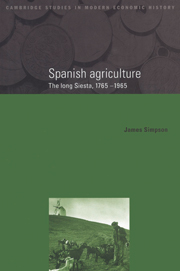Book contents
- Frontmatter
- Contents
- List of illustrations
- List of tables
- Acknowledgements
- Note on the regional division of Spain
- Abbreviations and conventions
- Introduction
- Part I The relative backwardness of Spanish agriculture
- 1 Spanish agriculture: the long view
- 2 Unlocking the puzzle of stagnation: regional variations
- Part II Traditional technologies and market opportunities, 1765–1880
- Part III The limits to technical change, 1880–1936
- Part IV Markets and institutions, 1880–1936
- Part V The State and the end of traditional agriculture
- Conclusion
- Appendix Estimates of agricultural output and consumption in nineteenth-century Spain
- Bibliography
- Index
1 - Spanish agriculture: the long view
Published online by Cambridge University Press: 04 December 2009
- Frontmatter
- Contents
- List of illustrations
- List of tables
- Acknowledgements
- Note on the regional division of Spain
- Abbreviations and conventions
- Introduction
- Part I The relative backwardness of Spanish agriculture
- 1 Spanish agriculture: the long view
- 2 Unlocking the puzzle of stagnation: regional variations
- Part II Traditional technologies and market opportunities, 1765–1880
- Part III The limits to technical change, 1880–1936
- Part IV Markets and institutions, 1880–1936
- Part V The State and the end of traditional agriculture
- Conclusion
- Appendix Estimates of agricultural output and consumption in nineteenth-century Spain
- Bibliography
- Index
Summary
The majority of countries today still devote a significant proportion of their resources to feeding, clothing and housing their population. However, historically, as Eric Jones has recently reminded us, living standards have varied significantly over time and space in pre-industrial societies. What determined these fluctuations is complicated, but two factors stand out: the ability of a society to produce surplus food, and the rate of population growth. Malthus believed that population growth depended on ‘preceding changes in agricultural productivity which, in their turn, are explained as the result of extraneous factors, such as the fortuitous factor of technical invention and imitation’. Boserup turned the argument on its head, suggesting that a larger population would stimulate the search for new systems of production which would increase output. For example, it is hard to imagine the diffusion of the heavy plough from the tenth century without the accompanying demographic pressure to extend the area cultivated on the potentially fertile but heavy soils of northwest Europe. Yet population growth has clearly not always led to technological or organisational change. The beneficial effects of the diffusion of the new ploughs were largely exhausted by the late thirteenth century — and the continued demographic pressure severely depressed living standards for the bulk of Europe's inhabitants.
- Type
- Chapter
- Information
- Spanish AgricultureThe Long Siesta, 1765–1965, pp. 13 - 32Publisher: Cambridge University PressPrint publication year: 1996



